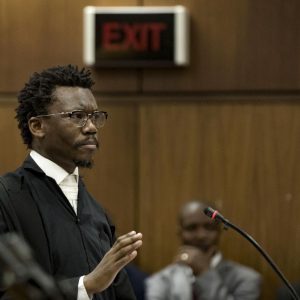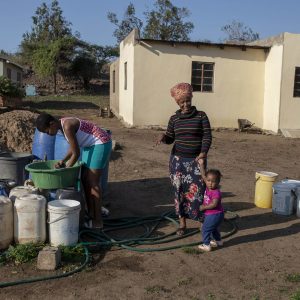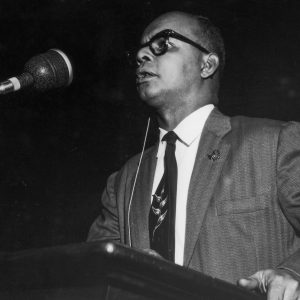Part two | Land matters and historical distortions
In this second of a two-part series, Tembeka Ngcukaitobi highlights the causes of privation across generations of Black people and the myth of ANC commitment to land redistribution.
Author:
7 July 2021

Just like wealth, poverty is transferred and reproduced across generations. This is a key point Tembeka Ngcukaitobi makes in his second book on the land question in South Africa, Land Matters: South Africa’s Failed Reforms and the Road Ahead. In it, he shows how generational poverty in the country can be understood as a consequence of many losses during the colonial and apartheid eras – loss of land, of forms of trade, of symbols of wealth such as cattle for amaXhosa in the Eastern Cape, and loss of home too.
Additionally, Ngcukaitobi says there is little evidence to suggest that the ANC government is still committed to land redistribution in South Africa, despite it being a fundamental tenet of its freedom and democracy project in the struggle and early days of democracy.
Related article:
Yvonne Phyllis: In what ways do the dismal failure of the land reform programme in South Africa maintain the transfer of poverty across generations of Black people?
Tembeka Ngcukaitobi: It doesn’t just transfer, it reproduces, right? Let’s just go to one example of something tangible, like cattle.
Just look at the Xhosa of the Eastern Cape. Basically, cattle were cash – they were forms of trade. You could establish relations with your ancestors through the slaughter of a cow; you could establish relations with other members of the community through the exchange of cattle in the form of lobola. But you could also change the status from being a boy to being a man by a slaughter, and you could also use the cattle as labour.
They could also carry big things that people can’t carry; they could transport you. So you can see how central cattle were to the entire social, political, economic, cultural being of the society.
The white people didn’t have cattle. I mean, Jan van Riebeeck didn’t arrive here with cattle or anything. So they began a slow process, initially of trading brass and metal and whatever, but those were small amounts of cattle that they could get. The Khoikhoi didn’t care that much because that didn’t affect their wealth. For instance, an old cow could just be given for Van Riebeeck to have meat, but they never had in mind the idea that the entire herd will be taken.
Related article:
Take for instance, the one account given by [Cape Colony governor] Harry Smith. He says “we went to Macomo’s kraal” – talking about Maqoma’s kraal – “and confiscated 13 000 cattle one evening”. Thirteen thousand in one evening!
So, on the issue of the transfer of both wealth and poverty across generations, we can pretty much trace where the large dispossessions were happening. And then we know that in 1857 there is the massive cattle killing movement. I mean, 400 000 cattle are estimated to have been killed. But one of the insights that I bring up in the book is that, firstly, that kind of killing movement was completely avoidable.
What is fascinating is what the white people say to each other. The diaries of [British colonel John] MacLean show that they decided that it’s better that the Xhosa kill their own cattle, which would expedite their demise. Often, the cattle killing movement has been viewed as essentially a millennial movement, which has sort of been driven by the religious madness of a 15-year-old girl, Nongqawuse. But once you look into the complexity of what was happening at the time and you find the conspiracies of the white colonial administrators and the role that they played, then there is a bigger story that emerges [of] massive cattle dispossession.

In those sorts of diaries there’s the idea that “we also want them as labourers. We want many of these people to come and work for the colonial administration in large road construction works.” They started bringing children to the colony and you could buy a child for two pounds, buy a child for three pounds – it’s like slavery by another name. They could then create a class of labourers, because they had destroyed the means of independent existence and they could then impose political control over a larger group of people than they ever could.
What has happened is that generations of Xhosa children being born after, let’s say 1878, are born into a wage economy. But 30 years earlier than that, say 1850, they would have actually been born into an agrarian economy which could independently subsist.
Under apartheid, they also began another form of cattle dispossession, which was basically cattle culling. They told you to reduce the number of cattle. Incidentally, they called this “betterment”. Basically, they claimed that the reasons why the land was unproductive – that’s the land that remains after 1913 – are overgrazing and overstocking, not the fact that it’s too little. Then they introduced all of these mechanisms for further reduction, to kill more cattle right up to the 1970s. We are born into this wage economy. To have 50 cows, our parents would be regarded as wealthy, but their great-grandparents would have had 1 000 cows to be regarded as wealthy and 50 cows would have been regarded as poor.
Related podcast:
[Cape Colony prime minister Cecil John] Rhodes was clear as well in terms of what he wanted with the Glen Grey Act. There’s this quote where he says: “I’ve seen all of these natives begcakamele ilanga ngaphandle (basking in the sun outside) and I have better use of them.” He decides that the only way to achieve this is by cutting down the hectares of land they own. He introduced that strategy of “one man, one hectare” and he could achieve two things with that. One is to force many, many people into the wage economy, and the other would be to compel the payment of tax. So you must work in the mines or work in the farms and then pay tax. That’s what we inherited.
Studies since have shown that children who inherited poverty are likely to pass on that poverty to their own children, and children who inherit wealth are likely to pass on that wealth. So wealth and poverty, in essence, calcify. Poverty reproduces, wealth reproduces.
There is a sense in which people are encouraged to educate themselves out of poverty, but education alone, without an asset base, is never sufficient to truly break the cycle of poverty. I don’t want to downplay the value of education – we should all get educated because it gives us skills and access to opportunities we would never have had – but an asset base is still essential if you want to truly break that cycle.
What is really necessary is ways in which Black people can be given access to assets. Most of that access is controlled by finance institutions, and unless one looks at the ways in which they function … I mean, there are now many, many Black people that are educated, but they hardly have assets.
So, these are the three key components to white wealth in South Africa: it’s the story of cattle, it’s the story of land and it’s the story of labour. This is what has led to the calcification of wealth in 9% of the population. This has to be confronted and dismantled. This is over 350 years. One of the things we forget is that this is a story over three centuries of taking the land. If we also had people from another country working for us, imagine where we would have been?
Related article:
Phyllis: I’m interested to hear your views on the ANC government’s commitment to land redistribution because you write: “For its part, the ANC has always seen redistribution as contributing to its larger social transformation of South Africa.” So here you’re talking about the ANC, the party, but my question is on the ANC government. Is the ANC government still committed to land redistribution?
Ngcukaitobi: That’s a very important question, because we need to draw a distinction between the political rhetoric, like what they say. You know a person not by what they say but what they do. There is very little evidence that the ANC is committed to a larger politics of redistribution, of economic redistribution – land being a central component of redistribution. The evidence shows that it’s been committed to a trickle-down economics, concentrating wealth at the top and giving 25% shareholding on the basis that there would be some sort of broad-band trickle-down. That’s been the actual official policy of the ANC. It’s not redistributive economics.
The same story applies to land. In the 1980s and the 1990s, the ANC was the most imaginative of all political parties about what to do with land, bearing in mind the complexities of the country it inherited. In the late 1980s and the early 1990s, right up to 1992, when it published it’s Ready to Govern document, It was clear that because we have a complex and contested past, we are not going to achieve redistributive goals through a form of restitution of land. So we’re not going to be able to say the Khoi people who were in the Western Cape in 1652 must return to Table Bay, which is where Van Riebeeck found them.
Realistically, the restitution was always going to be a limited programme, which would resolve the problems of about five million people. How they got to that five million was that they decided a date of 1913 and they worked out that the people who lost land rights after 1913 to 1994 were about five million people. There’s a book I cite, which is called The Discarded People, it’s those people. But essentially, these are victims of forced removals. They knew that if you resolve the problems of five million people who are victims of forced removals, that’s not going to resolve the land problem.
The land problem is a problem of land injustice: too many people with no land, too few people with too much land.
Related article:
The bulk of the solutions on land hunger focused on redistribution, which was essentially a programme about land needs. It was there to resolve land hunger. The redistributive programme would not focus on who was where and when, which is what the restitution programme focuses on, but rather, it would focus on who needs the land most. They call this equitable access to land, and that is how they thought the land problem in South Africa would be resolved – by asking who needs the land most and then giving them the land according to their needs.
They also thought we need to have another way of resolving tenure security so that people must not be kicked out of farms with no good reason. So, the land rights that existed in 1994 had to be protected. There were few, but they were highly precarious. Whether you were in land owned by a community, registered in the name of the state, administered by a chief, they needed to protect those few land rights that existed. So they called this tenure security, but something then happened, something much [more] fundamental.
As soon as we had the first vote in 1994, the policy completely flipped. And the flipping of the policy was to now focus on restitution as the solution to the land hunger problem. But from the word go, restitution simply never had the potential to resolve the problem of land hunger.
Restitution was always a limited problem. Firstly, if you gave every Black person who lost land rights after 1913, the most you could do is to restore the land rights of five million people, and not all of those land rights were ownership rights. There’s a smaller number that actually lost ownership rights, so if you restored all ownership rights, maybe you’re talking about two million people. If you gave all of them all of the rights that they got to the land, that will simply be scratching the surface.
Related article:
They effectively abandoned the redistributive part of the land reform, yet it was their main campaign mandate in the first elections – that “we will resolve land by asking who needs land the most and how much land do they need”. So the evidence is that there is, in fact, no commitment to redistribution.
Recently, of course, their sounds have sort of changed. There is now much more radical speak, but one must obviously be sceptical of the radical speak, which is not founded on principle and progressive politics.
Some land has been redistributed, and primarily what they have is the farm lease programme. That’s their main redistributive system. This is basically acquiring farms and then keeping them, and you then can ask for an allocation of a farm and they will give you that farm. And then sometimes they will give you 21 cows to get you started. Sometimes they’ll give you a grant of about R8 million to R10 million to get started. But if you then peel that layer and you try to find out who has got these farms, you find something … Ruth Hall and Thembela Kepe have written this paper – I think about five, six years ago – what they found is that there was massive elite capture. The elite capture is that people who had ties to the ANC bureaucrats tended to be first in line, with no farming experience, with no farming interests even.
Related article:
One of the things I’ve shown in the book is that if you combine these two programmes – restitution and redistribution – and you look at how much we have spent as the government, it’s R57 billion since 1994. It’s now R58 billion, because we spent another billion last year. And where that money has gone – it’s primarily gone to paying off white farmers, to paying off white banks, it’s gone to paying off white consultants. So, very little has actually gone to paying off beneficiaries. The irony is that the biggest beneficiaries of land reform have been white land owners. Although you have all these institutions and a seemingly radical framework, the actual funds go to white farm owners.
The language of radicalism is now relatively new, since 2018 when the ANC emerged from its conference. Actually, the EFF puts the motion in Parliament and then the ANC amends it. So since 2018 up until 2021, that trajectory – that the main beneficiaries of land reform are white landowners – has not changed. That remains the case structurally. We don’t have any evidence that shows real, principled commitment to resolving the problems of landlessness. We don’t even see policy shifts, I mean, there is just no new policy, nothing.
There is no study that has ever shown that the compensation provisions are inhibiting redistribution of land. Nothing whatsoever. So, after all of these three years, we are still not redistributing. I mean, we have no policy on redistribution. We don’t even have a law to regulate redistribution. So I think we are entitled to conclude that, actually, there is no real commitment. What we have is nice-sounding slogans.
This interview has been lightly edited for length and clarity.







